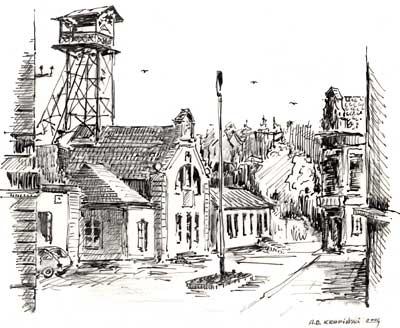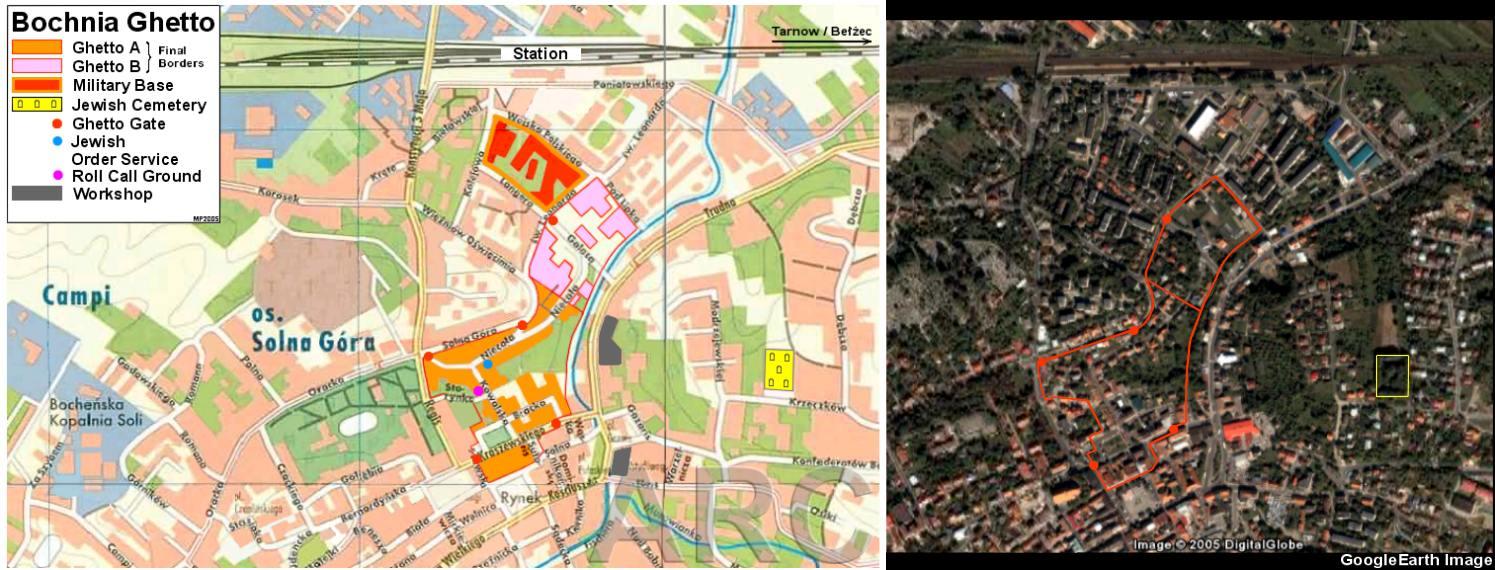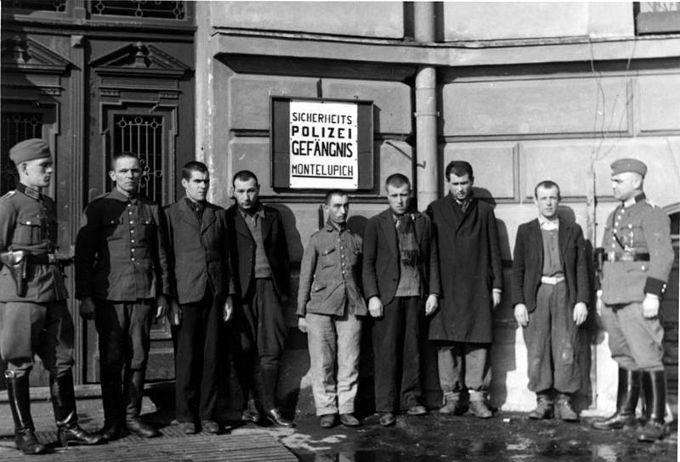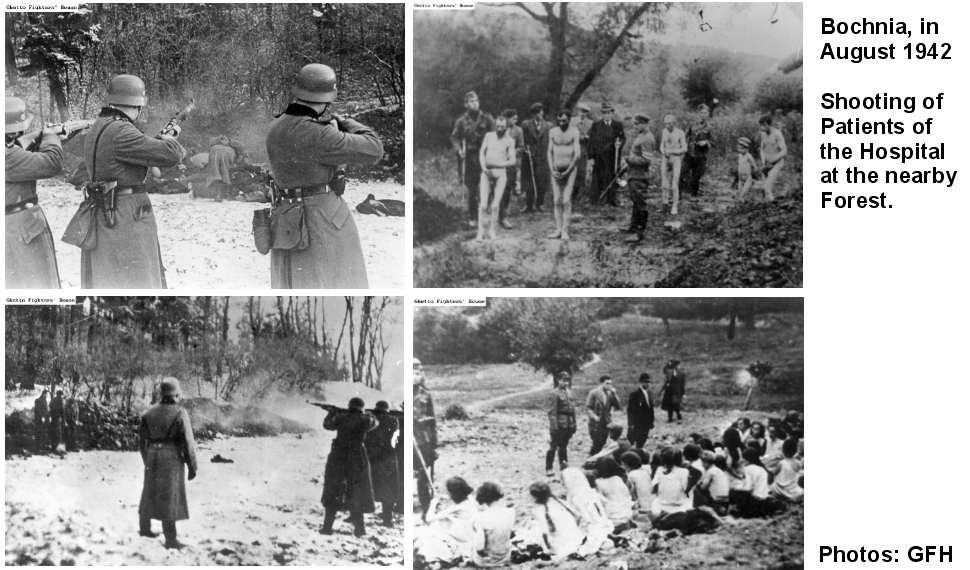Testimony part 3 — labor camps and the Bochnia ghetto
In part 3: Margot's family avoids expulsion to the Bochnia ghetto with voluntary imprisonment in a Krakow labor camp. They obtain false identity papers and relocate to Bochnia, where they are able to live outside the ghetto. She is briefly together with Jerzy and they are married in hiding in Bochnia.
Kostrze and Zatorska
The Jews in Wisnicz were visited often by the SS. Margot remembered how the brother of a good friend was caught on the road and then dragged into town behind a sled. He arrived in Wisnicz half dead.
In the beginning of 1942, German plans for the creation of a ghetto in nearby Bochnia were rumored among the Jews of Wisnicz. It was thought a ghetto was just a way station on the road to a concentration camp. Auschwitz was already well known. It was called it a labor camp but everybody knew that they didn’t want to go there.
Before the evacuation of Wisnicz, Szymek Draenger somehow arranged to have his parents and brother sent instead to a safer labor camp at Kostrze, near to Krakow, where it was thought people would not be killed or transported. And the Lieblich family—Margot, her parents, uncle and cousin—also were sent on farm wagons from Wisnicz to Kostrze.
In Kostrze, they worked in a company, Strauch, that did civil engineering work on the Vistula river levees west of the city. The new Dränger and Lieblich arrivals were barracked there and put to work shoveling dirt at the river works.
“I think it was a prison and that's where we were housed. We slept on straw and got something to eat there three times a day and we were shown to work. We had to dig. Within the prison we could move around freely.”
Then the whole group was transferred to another Strauch operation in Krakow proper, in a house on Zatorska Street with more than 50 people crammed on the premises. Lice and bed bugs were quite normal.
The men in the house were sent each day to work at the nearby hybrid gas factory, where they made mustard gas.
Margot’s father became the chef in the house and her mother helped. They prepared pearl barley and a little meat from time to time. Once Margo was careless and threw coal into the pot with the soup. She didn’t do that a second time.
One of the inmates at the house on Zatorska was a woman who had been born in America and had an American birth certificate. She let Margot’s father borrow it, and Shimon Draenger arranged for a forged copy to be stamped at the Swiss consulate in Berlin. This document would enable Margot and her parents to obtain some protections as expatriated Americans in the coming months.
Resistance and betrayal
About this time, the Germans took notice of the rising resistance movement in Krakow and they established a curfew. Poles were only allowed out only until 7 o'clock in the evening. Jews, of course, were not allowed out at all.
Margot’s cousin was no longer with the group. She looked like a Polish girl and could pass as a Christian in Bochnia, where she joined this resistance group.
Szymek and Gusta took a child from his sister who was deported. A little boy and she took care of the child. Margot did no know about the extent of their activities at this time.
In December 1942, a coalition of partisans undertook a resistance campaign against Krakow cafes and nightclubs frequented by Germans. On Dec. 22, a raid on the Cyganeria cafe on Florianska St. in the center of Krakaw killed up to a dozen German officials.
The Jewish fighters disguised the operation as undertaken by a Polish underground group, but German authorities were not fooled for long. They were apprehended in their hideout a few days later after they were betrayed by a Jewish boy. Margot knew family members of the this Artek Apel who betrayed the group.
They were arrested, all of them. Shimon, Gusta, his sister, Dolek Liebeskind, his wife Vuschka and the others. They were sent to the famous Montelupich prison in Cracow. were locked up as traitors and criminals.
On January 1, 1943, a notice came out that the criminals had been arrested and therefore the curfew was repealed. Then the Poles could go out at night again.
A few days later, Jerzy knew he was suspected and did not report to work at the gas factory. His father went in his place that day and he never came back. He was shot dead in the factory, targeted because he was Shimon Draenger's father.
After that, Jerzy went into hiding. His sister Tzerna who passed as Christian was grouped in with the Polish and sent to work in Germany.
Bochnia ghetto
At the beginning of 1943, in January, the Plaszow labor camp and concentration camp was founded in a southeastern district of Krakow. The Zatorska workers would have been sent there, but somehow Margot’s family was smuggled out to Bochnia, where they were able to live with a Polish woman outside of the ghetto. Their American papers allowed the family group to live as foreigners outside the ghetto, but then foreigners were also interned. Margot and her parents were integrated into one of these groups.
Bochnia had two ghettos, Ghetto A for workers in German ammunition factories or in uniform factories and Ghetto B for the elderly, families with children or people who didn't work. From Ghetto A could go out to work and from Ghetto B you could get messages into Ghetto A.
Jews with money managed these rules because the SS leader Schönbrunn who directed the Bochnia ghettos was corrupt. He did everything for money. And the Jews bought him quite a bit.
At this time in 1943, Hungary was not yet occupied. People with false Hungarian papers were able to get into Hungary.
Margot received word from Jerzy in the ghetto that he was desperate. She ran away from her parents to go to him, and she stole several items of her father’s jewelry to finance her mission. including his prized Glashütte pocket watch set with rubies and diamonds.
Later, her father’s remaining jewels were taken by the authorities when their internment group was searched. It was a good thing that Margot had already taken some of the collection. Her parents were brought to Montelupich.
Margot went back to the Polish woman’s home in Bochnia. Jerzy was then in a hiding place in Ghetto B in a place secured through his brother’s contacts.
Married in the attic
For a few months, Margot was able to pass in and out of the ghetto to visit Jerzy. Then in April, around Passover she remembers, she said, “it's no longer any use like this, we should get married.”
Margot came to Ghetto A and they got married in an attic, attended by several rabbis including the famous Chorzkov rabbi. Then she lived with her husband for a few days in ghetto, but then Jerzy’s brother arranged a new hiding place for him outside the ghetto in the town of Borovna, near to Wisnicz.
There, a Polish innkeeper and his daughter who were connected to the Underground had established an accommodation in a Eiskeller, where his beer and wine was stored. There were a few of men hidden there including Jerzy.
Jerzy walked there from Bochnia by himself without an armband, which was possible for him since he spoke perfect Polish.
Margot was in Bochnia with the Polish lady. On May 1, 1943 (she remembers the date because they had heard about the uprising in Warsaw), she went for a walk in Bochnia and received a tap on the shoulder. It was Gusta, her sister-in-law, who was in hiding, a fugitive. She had been with a group of women sent on a transport to be shot. They made an escape as they were brought on the transport. Some were shot and some got away, including Gusta.
She had gotten herself to Bochnia and was looking for Jerzy, and through him to her husband. Margot told her about the hideout in Borowna and Gusta went there to find him. Unfortunately, Shimon had already fled the area. A few days later Margot was advised by contacts in the Jewish underground that she herself was in danger because of her married name. They were looking for anyone and everyone named Draenger.
Margot went back to using her maiden name, Lieblich.
It turned out that Szymek had also escaped execution in a prison break at Plaszow. A group of prisoners managed to get hold of revolvers and started shooting Germans. And he was one of those who got away.
But afterward he did not lay low, but started issuing pamphlets again, both inside and outside the Bochnia ghetto. Then later in June, Shimon and Gusta went somewhere else and continued to work against the Germans.
The German gendarmes in Bochnia were known to be more brutal than even the SS. One of them, an ethnic German named Bogusc, was known to walk and shoot when he felt like it and when he wanted to. But there was another one called Brink who wasn't as bad.
One day, Margot learned that Brink wants to talk to her. She goes to meet him at the Gestapo building in Bochnia . They have a member of the Jewish Underground, Rudek Birnbaum, in custody. He had been caught outside the ghetto carrying leaflets. When they asked where he was going to, he said he was going to see Margot.





